
Original Link: https://www.anandtech.com/show/3981/western-digital-caviar-green-3tb-and-my-book-essential-3tb-drives-reviewed
Western Digital Caviar Green 3TB and My Book Essential 3TB Drives Reviewed
by Anand Lal Shimpi on October 19, 2010 1:43 PM EST- Posted in
- Storage
- HDDs
- Western Digital
- 3TB
Two months ago I looked at the world’s first 3TB desktop hard drive. It was a 5 platter, 3TB Seagate Barracuda XT inside an external GoFlex Desk chassis. The performance of the drive wasn’t anything out of the ordinary, but the poorly ventilated chassis seemed ill equipped to deal with the thermal load a 5-platter, 7200RPM 3TB drive would throw at it. I wasn’t terribly pleased and I wondered if Western Digital’s external enclosure might be better suited for heat dissipation. WD’s 3.5” external drives fall under the My Book brand and they have visibly more ventilation than the GoFlex Desk I reviewed.
As luck would have it, last week Western Digital announced its own 3TB external drive: the My Book Essential. The Essential suffix somehow implies USB 3.0 support.
Today, Western Digital takes it one step further and announces availability of the internal drive as well. The Caviar Green line is now home to a 2.5TB and a 3.0TB model, priced at $189 and $239 respectively.
Let’s go ahead and review both shall we?
The Caviar Green 3TB
Seagate’s external 3TB offering used five 600GB platters to hit the magic capacity point. While increasing platter count is a quick way to get a larger drive, increasing areal density is the desired approach. Seagate’s quick time to market justified the former, while Western Digital’s desire to deliver a low power drive demanded the latter.
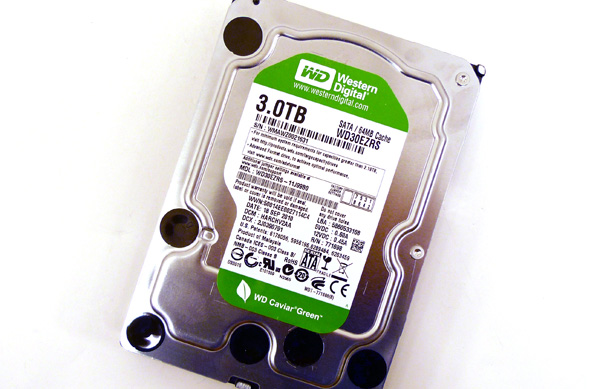
As a result the Caviar Green 3TB uses only four 750GB platters, giving this drive the highest platter density of any 3.5” hard drive.
| Western Digital Caviar Green 3TB | ||||
| WD30EZRS | ||||
| Interface | SATA 3Gbps | |||
| Formatted Capacity (Base 10) | 3,000,592 MB | |||
| User sectors per drive | 5,860,533,168 | |||
| Cache Size | 64MB | |||
| Load/unload cycles | 300,000 | |||
| Limited Warranty | 3 years | |||
Spindle speed is another differentiating factor between WD’s drive and the earlier Seagate offering. While the GoFlex Desk houses a 7200RPM hard drive, WD’s 3TB drive is sold under the Green label. Western Digital doesn’t disclose actual spindle speed as it isn’t consistent across all Green label drives. The 3TB specs simply list it as IntelliPower.
I asked WD for more specifics and I got a reasonable explanation. In the Green line WD optimizes for power consumption. It attempts to make all drives consume roughly the same amount of max power, which happens to be 3 - 5W below a typical 7200RPM drive. The spindle speed isn’t dynamic, it’s set at manufacturing and remains at that.
All green drives will spin below 6000 RPM and the spec never drops below 5400RPM. What this means is that all 2.5TB drives will spin at one speed while all 3TB drives may spin at another, both between that 5400 RPM to 6000 RPM range.
Like many modern drives, the 3TB Caviar Green uses 4KB sectors internally however it emulates 512-byte sectors for compatibility reasons.
Unlike Seagate, Western Digital’s 3TB drive ships with a 3Gbps SATA interface. This isn’t a problem given that neither drive can push enough data to saturate the 3Gbps SATA interface. Without SSDs there’s very little reason for 6Gbps SATA support on desktop storage these days.
Where the 3TB Caviar Green really breaks the mold is that it is shipped with a HighPoint RocketRAID 620 PCIe SATA card. The purpose? Breaking the 2.19TB barrier of course.
The 2.19TB Barrier
I addressed this in my 3TB Seagate review back in August, so much of this is a rehash from the review back then with some new information toward the end of the page.
Pretty much all HDDs (and SSDs) are addressed using a scheme called Logical Block Addressing (LBA). The method is very, well, logical. Storage is addressed linearly, regardless of how the hardware itself is accessed. You start at LBA 0 and you go all the way up to the last address in your device.
The number of LBAs you can address is a function of your hardware and the style of partition you’ve applied to your drive.
Master Boot Record partitioning is by far the most common on PCs today. LBA 0 contains the Master Boot Record (MBR) and your BIOS looks at the contents of LBA 0 to determine how to boot.
Now LBAs under MBR partitions are addressed using 32-bit values, the maximum of which is 2^32 or 4294967296. Each LBA on a hard drive corresponds to a 512-byte sector value (even on 4K advance format drives, they still appear as 512-byte sector drives to the OS), so the largest partition you can have in a MBR partitioned drive is 4294967296 * 512-bytes or 2,199,023,255,552 bytes.
Hard drive manufacturers define 1TB as 1 trillion bytes. If we use that definition then the largest 32-bit MBR partition would be 2.199TB (2,199,023,255,552 bytes / 1,000,000,000,000). If we define 1TB as 1024^4 bytes (TiB) then the largest 32-bit MBR partition would be 2TiB (2,199,023,255,552 bytes / 1,099,511,627,776). Either way, with a 3TB drive there’s no way we’re getting a single 3TB partition using MBR.
In use on all Itanium and Intel based Macs (among other systems) is GPT (GUID Partition Table), and a feature of GPT is 64-bit LBA support.
With 64-bit LBAs the largest 512-byte sector drive we can address is 9.4ZB (Zettabytes - 10^21 or 2^70 bytes depending on if you’re counting in base 10 or 2). That’s an absurd amount of data.
GPT drives are supported as data drives in all x64 versions of Windows as well as Mac OS X and Linux. Below we have some screenshots of creating a GPT drive in Windows and OS X:
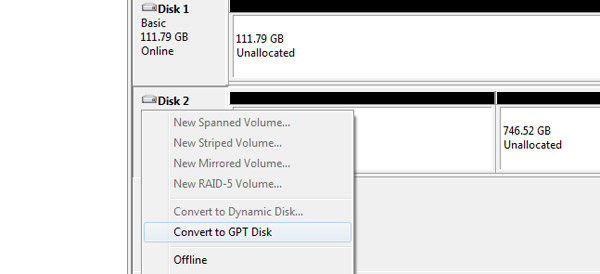
GPT Partition in Windows 7
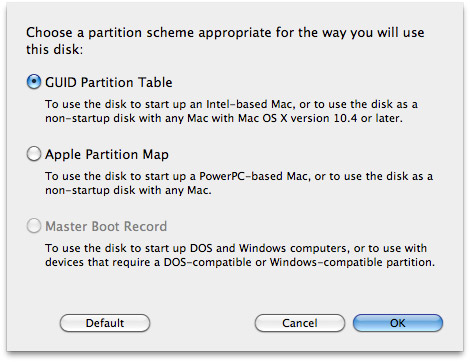
GPT in Mac OS X
You’ll note that I said data and not boot drives. In order to boot to a GPT partition, you need hardware support. I just mentioned that your PC’s BIOS looks at LBA 0 for the MBR. Your BIOS does not support booting to GPT drives. GPT is however supported by systems that implement the successor to the BIOS: Intel’s Extensible Firmware Interface (EFI).
Intel based Macs don’t use a BIOS and instead have an EFI which allows them to boot to GPT drives. Most PC motherboards however do not have EFI support, and those that do may have bugs associated with the implementation.
I’m expecting to see the first round of motherboards with official 3TB HDD support in the coming weeks. Although consumers shouldn’t expect good support from motherboard makers until the first half of next year. Users of older boards may be out of luck as enabling EFI is still a low priority for most manufacturers.
BIOS support is only part of the problem. You SATA controller also needs to support 64-bit LBAs. Currently Intel’s storage drivers don’t support 64-bit LBAs. Running your ICH in Native IDE mode will work however.
AMD’s 8-series storage drivers do support 64-bit LBAs but I haven’t seen any AMD motherboards with EFI support.
In order to deal with all of the potential controller issues today, Western Digital bundles all 3TB drives with a HighPoint Rocket 620. The controller supports booting to a 3TB formatted drive if your motherboard has EFI support. But as I just mentioned, proper EFI support is tough to come by.
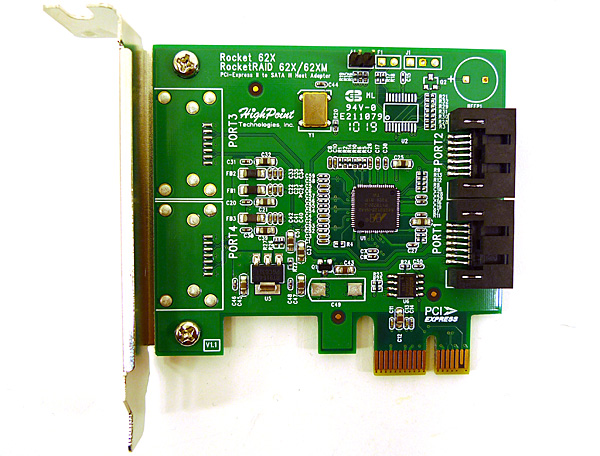
Western Digital expects that we’ll see both motherboard and storage controller support by Q2 2011, at which point it will stop shipping the HighPoint cards with 3TB drives.
The HighPoint adapter uses a Marvell 88SE9025 6Gbps SATA controller, although for some reason installing HighPoint’s drivers on the card (both at boot and under Windows) would cause the drive to disappear entirely. I had to rely on the drivers that ship with Windows 7.
Mac & Linux Support
Intel Macs already ship with EFI support so these drives should just work in a Mac. I popped one into a Nehalem Mac Pro and I confirmed it worked:
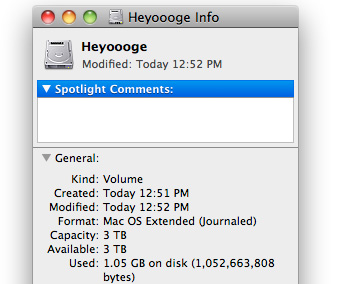
Linux is also covered if your distribution enables support for 64-bit LBAs. The full compatibility matrix is below:
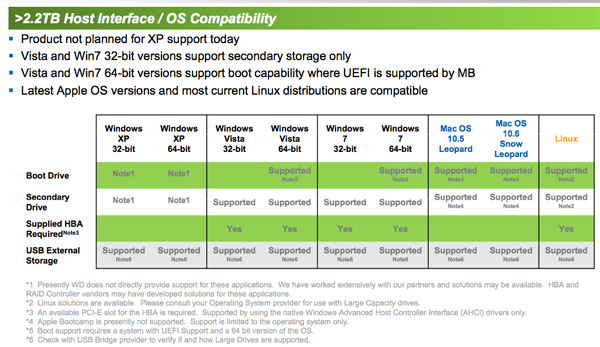
Let’s Go Outside: My Book Essential
Western Digital also sent along the My Book Essential, an external version of the 3TB Caviar Green. Unlike Seagate’s GoFlex Desk, the My Book Essential doesn’t have an option for interfaces: USB 3.0 is all you get. Obviously USB 3.0 is backwards compatible with USB 2.0 on the host connector side.
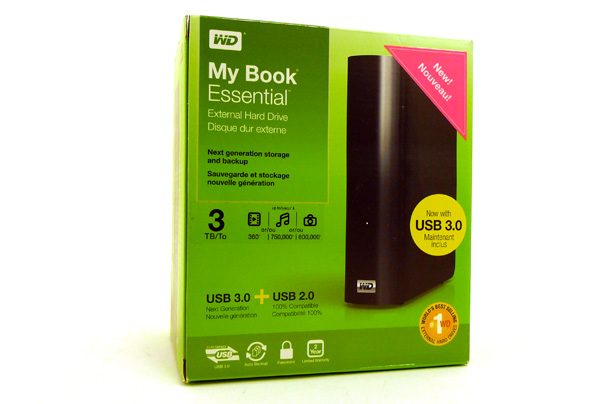
The first thing I wanted to test with the My Book Essential was how well it kept the drive cool. Remember the Caviar Green is a 4 platter sub-6000 RPM drive compared to the 5-platter 7200 RPM design in the GoFlex Desk, so temperatures should inherently be lower. To make sure the drive never gets too hot Western Digital has a grate that runs along the top, spine and bottom of the My Book Essential. A pair of rubber feet prop the drive up a few millimeters off of the ground to allow air in from below.The ventilation story is a lot better than what I encountered with the GoFlex Desk.
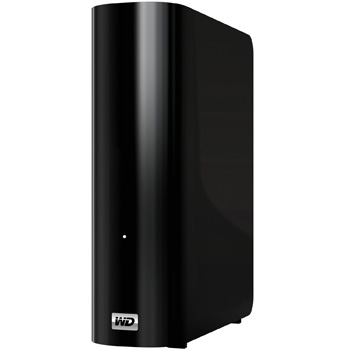
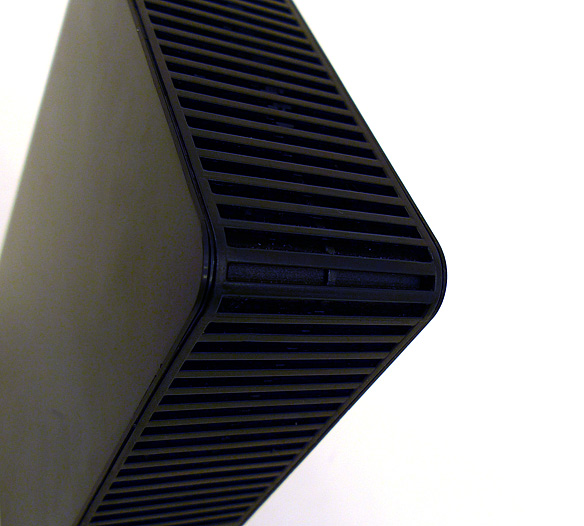
As a result, temperature is a non-issue. Here’s the drive at idle and after over an hour of use:
| Thermal/Power Comparison | |||||
| Idle | Load | Power Consumption (Idle/Load) | |||
| Western Digital My Book Essential 3TB | 34C | 49C | 5.30W / 9.60W | ||
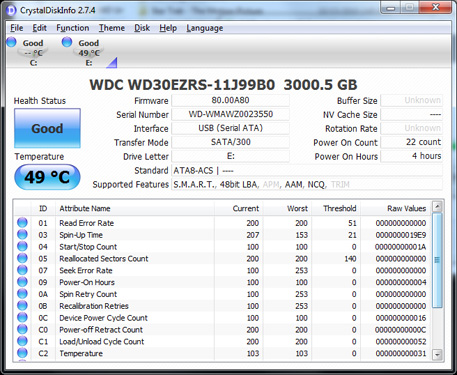
Like Seagate, Western Digital supplies software with the drive to manage the drive and backups. Western Digital doesn’t bundle a NTFS Mac driver so you’ll need to reformat the NTFS formatted drive for write use on a Mac (or supply your own NTFS driver for OS X).
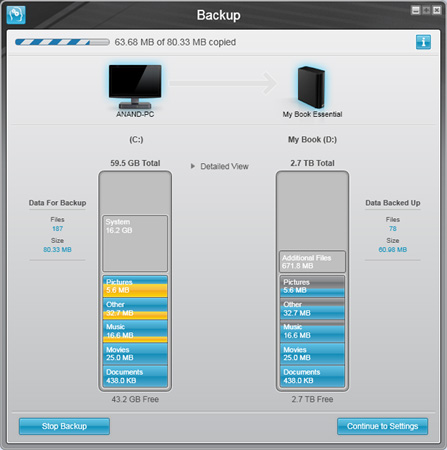
WD’s SmartWare utility does let you seamlessly lock and unlock the drive across both Windows and OS X however.
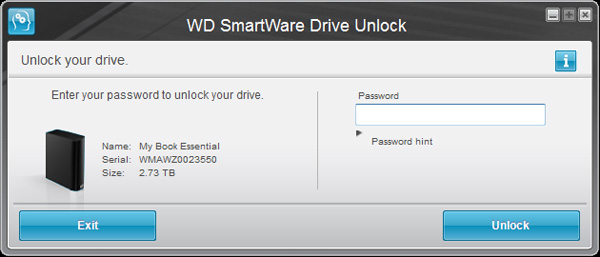
The performance of the My Book Essential isn’t nearly as good as what we saw with the GoFlex Desk. Seagate is over 25% faster for sequential reads and writes over USB 3.0. I’d say the tradeoff is worth it given the tremendous difference in heat however.
| External 3TB Performance Comparison | |||||
| Seagate GoFlex Desk 3TB (USB 3.0) | Western Digital My Book Essential 3TB (USB 3.0) | Western Digital My Book Essential 3TB (USB 2.0) | |||
| Sequential Read | 151.9 MB/s | 120.6 MB/s | 37.8 MB/s | ||
| Sequential Write | 151.2 MB/s | 119.7 MB/s | 32.9 MB/s | ||
| Random Read | 0.30 MB/s | 0.18 MB/s | 0.17 MB/s | ||
| Random Write | 0.93 MB/s | 0.84 MB/s | 0.82 MB/s | ||
USB 3.0 continues to be a great interface for external storage. There’s very little sequential performance difference between the 3TB My Book Essential and the desktop Caviar Green. Random performance is significantly lower, presumably because of the translation that happens at the USB controller level. As an external drive, you’re more likely to be writing to the My Book Essential sequentially rather than throwing a more random workload at it.
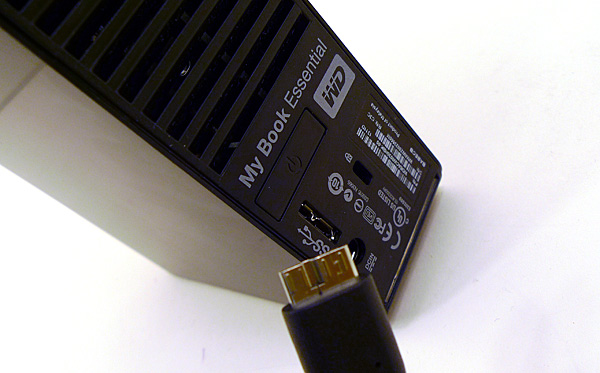
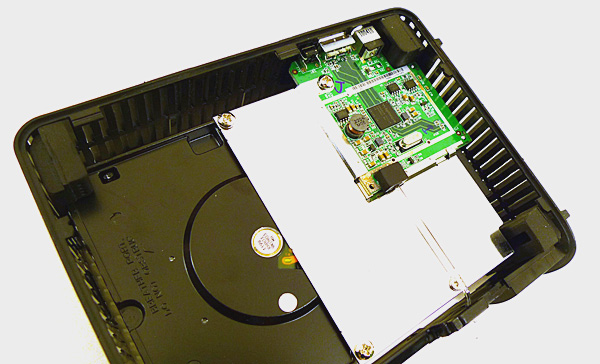
The only problem I had in testing the My Book Essential was very erratic read performance at the beginning of my testing. Here’s a shot of the first sequential read pass on the drive:
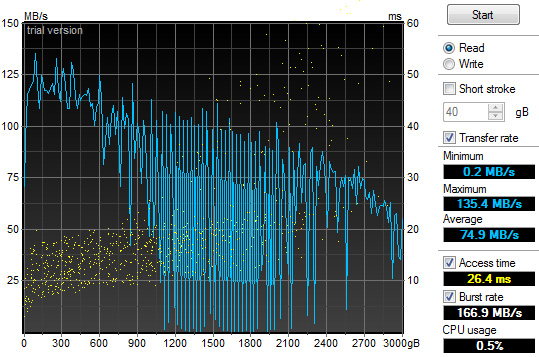
The problem mostly resolved itself after further passes, although there were always some strange performance blips aross various LBAs:
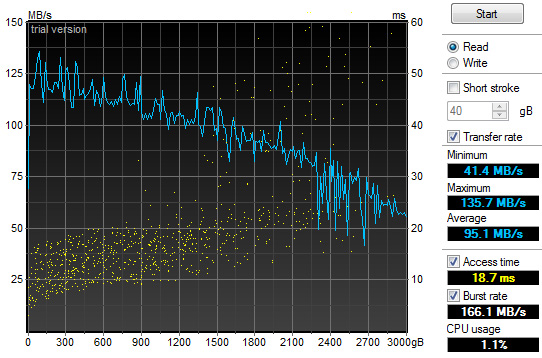
Write performance is also impacted:
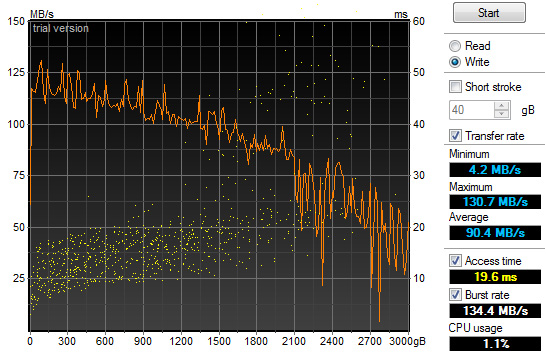
You'll notice that I didn't see these problems with the internal drive, which leads me to believe that this is either a problem with my review sample or with the USB 3 to SATA bridge in the My Book Essential itself. The variable performance also isn't consistent between runs or benchmarks
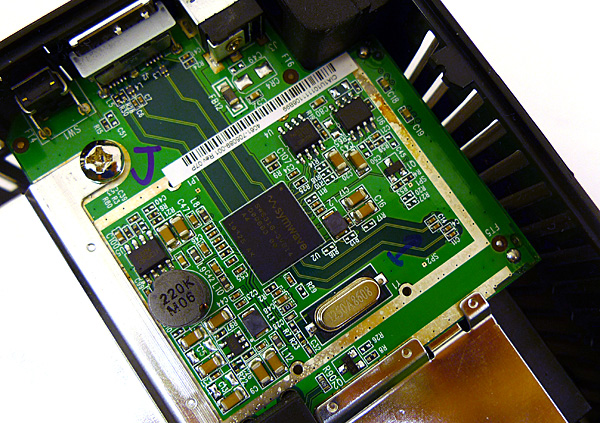
The move to USB 3 adds about a 3+ ms latency penalty compared to the internal drive. This is ok for backups and large file storage, but it's not something you'd want to use as an application drive.
The Test
| CPU | Intel Core i7 965 running at 3.2GHz (Turbo & EIST Disabled) |
| Motherboard: | Intel DX58SO (Intel X58) |
| Chipset: | Intel X58 + Marvell SATA 6Gbps PCIe |
| Chipset Drivers: | Intel 9.1.1.1015 + Intel IMSM 8.9 |
| Memory: | Qimonda DDR3-1333 4 x 1GB (7-7-7-20) |
| Video Card: | eVGA GeForce GTX 285 |
| Video Drivers: | NVIDIA ForceWare 190.38 64-bit |
| Desktop Resolution: | 1920 x 1200 |
| OS: | Windows 7 x64 |
Sequential Read/Write Speed
Using the latest build of Iometer I ran a 3 minute long 2MB sequential test over the entire span of the drive. The results reported are in average MB/s over the entire test length. Sequential read/write performance is very close to the older 7200RPM 1TB Caviar Black. The 3TB Caviar Green manages to come within 10% of the older 7200 RPM drive.
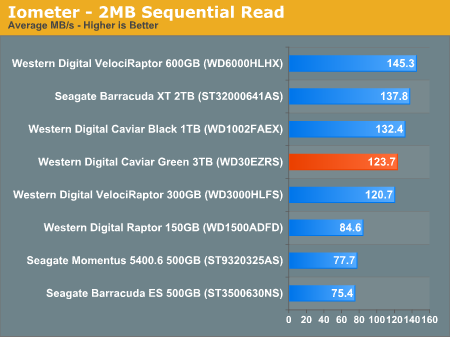
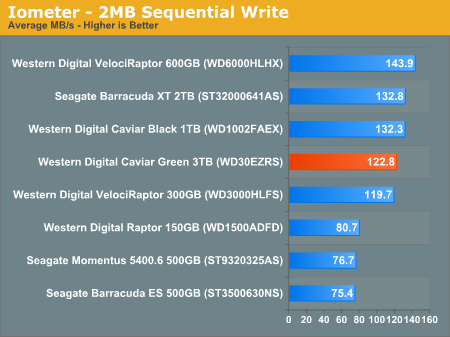
Random Read/Write Speed
This test writes 4KB in a completely random pattern over an 8GB space of the drive to simulate the sort of random access that you'd see on an OS drive (even this is more stressful than a normal desktop user would see). Random read performance takes place over the entire LBA span of the drive so the two numbers will be different. I perform three concurrent IOs and run the test for 3 minutes. The results reported are in average MB/s over the entire time.
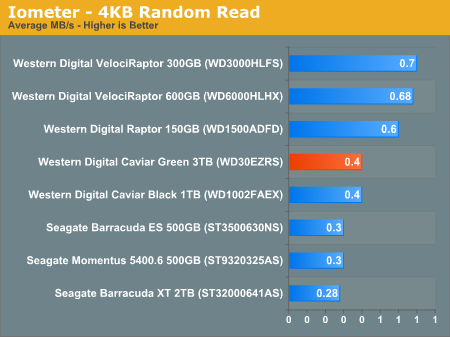
Both random read and write performance is pretty reasonable for a sub-6000 RPM hard drive. You're definitely not going to be as fast as a modern day 7200 RPM drive or a 10K RPM Raptor for random opterations, but for large file storage you should be fine.
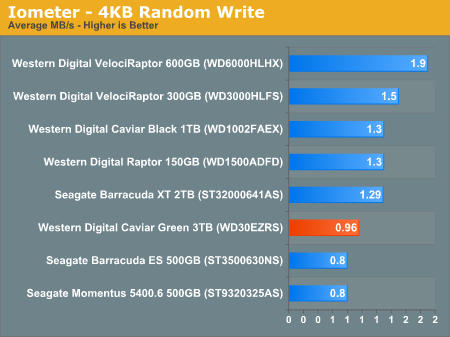
Performance vs. Capacity
Hard drives are made up of one or more circular platters. Platters are written from the outside inward in order to maximize performance (you cover more data in a single rotation of an outer track vs an inner track). As was the case in our Seagate 3TB review I had to turn to HD Tune as HD Tach doesn't support 64-bit LBAs:
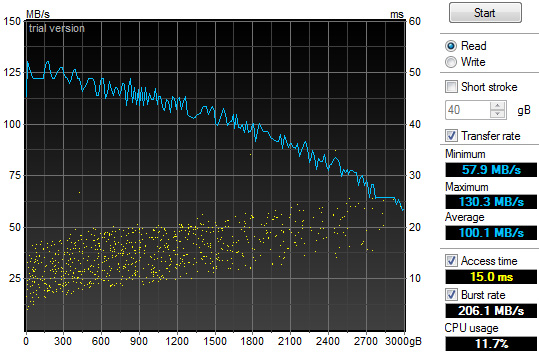
Maximum read performance is 130MB/s while maximum write speed is 121.7MB/s. The minimum speed you'll get out of the drive is ~55MB/s at its inner most tracks.
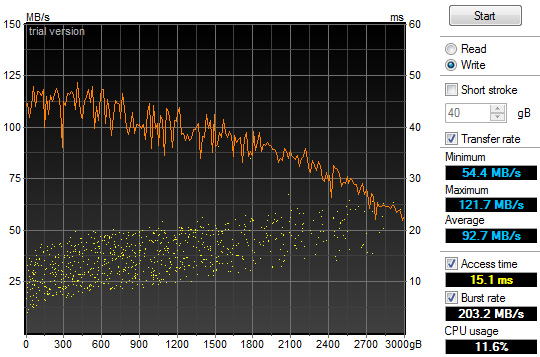
Overall System Performance using PCMark Vantage
Next up is PCMark Vantage, another system-wide performance suite. For those of you who aren’t familiar with PCMark Vantage, it ends up being the most real-world-like hard drive test I can come up with. It runs things like application launches, file searches, web browsing, contacts searching, video playback, photo editing and other completely mundane but real-world tasks. I’ve described the benchmark in great detail before but if you’d like to read up on what it does in particular, take a look at Futuremark’s whitepaper on the benchmark; it’s not perfect, but it’s good enough to be a member of a comprehensive storage benchmark suite. Any performance impacts here would most likely be reflected in the real world.
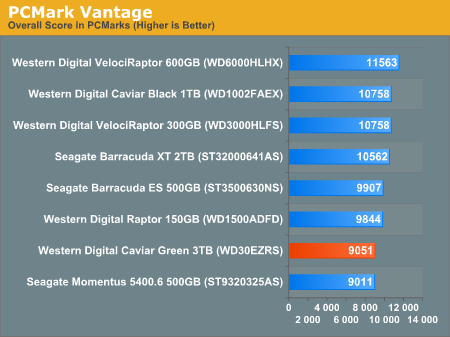
PCMark Vantage shows us the real world performance of the 3TB Caviar Green isn't so great if you're using it as a boot/application drive. The HDD specific suite is particulary troublesome as the drive is barely faster than Seagate's 2.5" 5400.6.
The memories suite includes a test involving importing pictures into Windows Photo Gallery and editing them, a fairly benign task that easily falls into the category of being very influenced by disk performance.
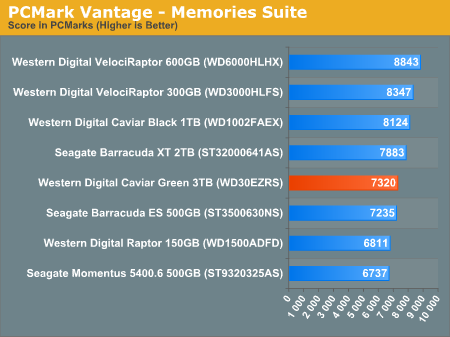
The TV and Movies tests focus on on video transcoding which is mostly CPU bound, but one of the tests involves Windows Media Center which tends to be disk bound.
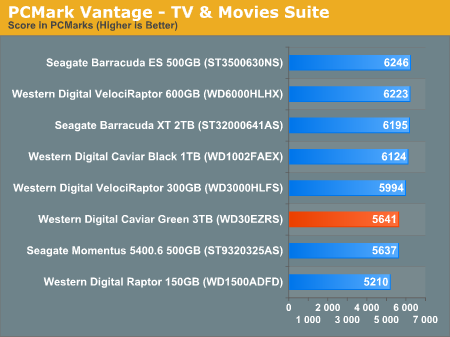
The gaming tests are effectively read tests since they spend a good portion of their time focusing on reading textures and loading level data. Actual game loading performance will differ depending on the game. Take these results as a best case scenario of what can happen, not the norm.
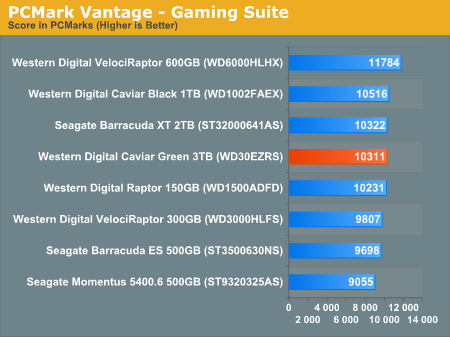
In the Music suite the main test is a multitasking scenario: the test simulates surfing the web in IE7, transcoding an audio file and adding music to Windows Media Player (the most disk intensive portion of the test).
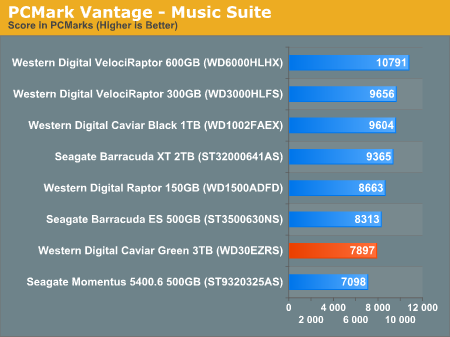
The Communications suite is made up of two tests, both involving light multitasking. The first test simulates data encryption/decryption while running message rules in Windows Mail. The second test simulates web surfing (including opening/closing tabs) in IE7, data decryption and running Windows Defender.
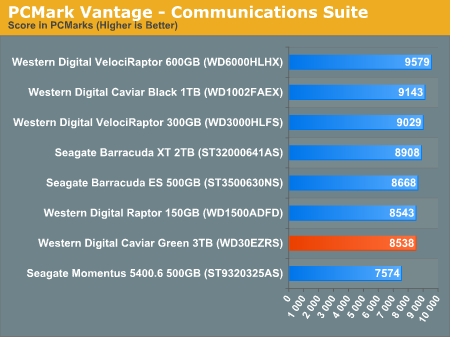
I love PCMark's Productivity test; in this test there are four tasks going on at once, searching through Windows contacts, searching through Windows Mail, browsing multiple webpages in IE7 and loading applications. This is as real world of a scenario as you get and it happens to be representative of one of the most frustrating HDD usage models - trying to do multiple things at once. There's nothing more annoying than trying to launch a simple application while you're doing other things in the background and have the load take forever.
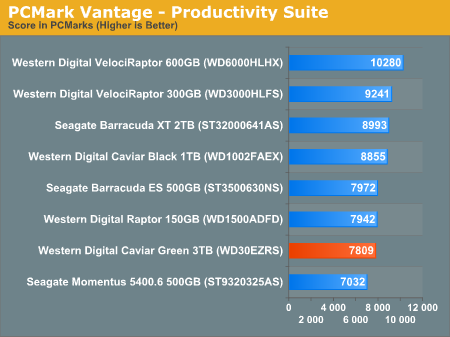
The final PCMark Vantage suite is HDD specific and this is where you'll see the biggest differences between the drives:
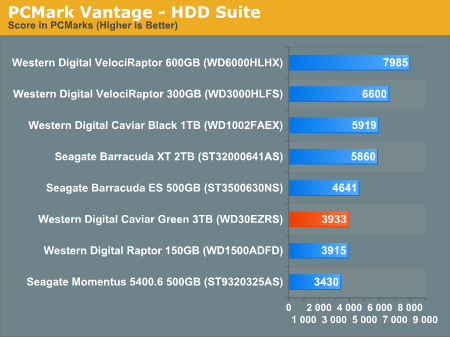
SYSMark 2007
To help round out our real world performance testing I'm also including results from SYSMark 2007. This benchmark measures performance as a function of response time in applications varying including Adobe's CS2 suite, Microsoft Office and 3dsmax.
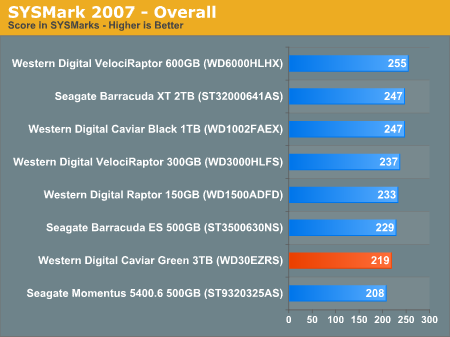
SYSMark performance echoes what we saw in PCMark, the 3TB drive doesn't seem to do so well under normal system workloads. This is really a drive for true mass storage, not active use as a boot/application drive.
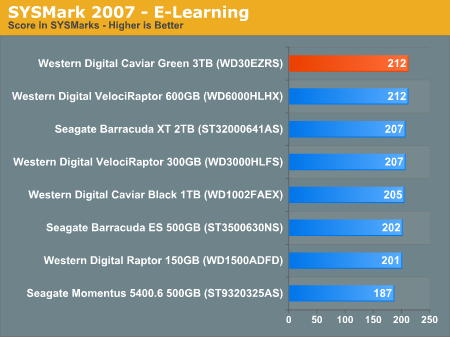
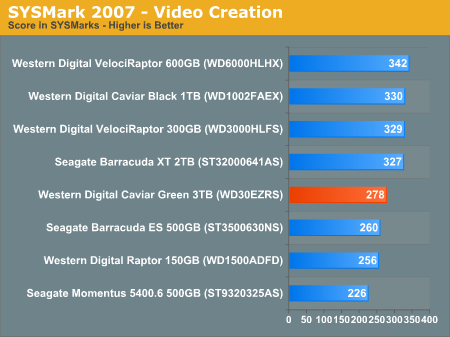
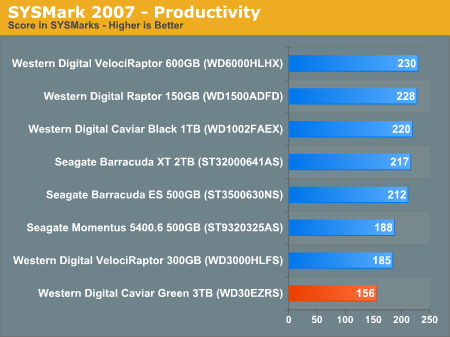
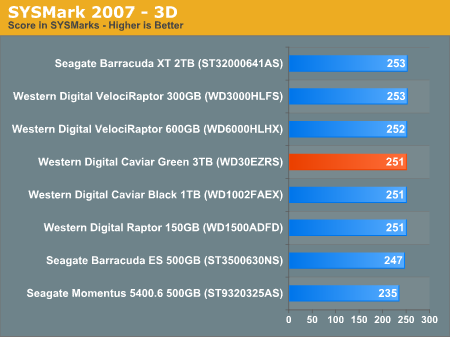
AnandTech Storage Bench
The first in our benchmark suite is a light usage case. The Windows 7 system is loaded with Firefox, Office 2007 and Adobe Reader among other applications. With Firefox we browse web pages like Facebook, AnandTech, Digg and other sites. Outlook is also running and we use it to check emails, create and send a message with a PDF attachment. Adobe Reader is used to view some PDFs. Excel 2007 is used to create a spreadsheet, graphs and save the document. The same goes for Word 2007. We open and step through a presentation in PowerPoint 2007 received as an email attachment before saving it to the desktop. Finally we watch a bit of a Firefly episode in Windows Media Player 11.
There’s some level of multitasking going on here but it’s not unreasonable by any means. Generally the application tasks proceed linearly, with the exception of things like web browsing which may happen in between one of the other tasks.
The recording is played back on all of our drives here today. Remember that we’re isolating disk performance, all we’re doing is playing back every single disk access that happened in that ~5 minute period of usage. The light workload is composed of 37,501 reads and 20,268 writes. Over 30% of the IOs are 4KB, 11% are 16KB, 22% are 32KB and approximately 13% are 64KB in size. Less than 30% of the operations are absolutely sequential in nature. Average queue depth is 6.09 IOs.
The performance results are reported in average I/O Operations per Second (IOPS):
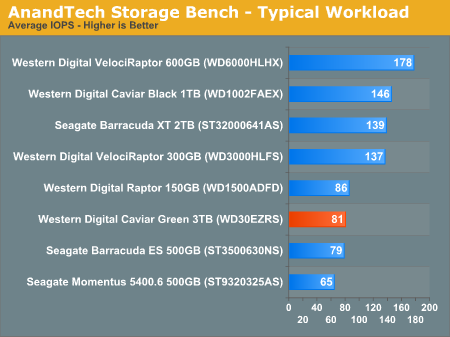
Real world drive performance is a bit of a letdown if you're planning on using the 3TB drive as a boot drive. It's barely any faster than an old Seagate Barracuda ES and even slower than the old 150GB VelociRaptor.
If there’s a light usage case there’s bound to be a heavy one. In this test we have Microsoft Security Essentials running in the background with real time virus scanning enabled. We also perform a quick scan in the middle of the test. Firefox, Outlook, Excel, Word and Powerpoint are all used the same as they were in the light test. We add Photoshop CS4 to the mix, opening a bunch of 12MP images, editing them, then saving them as highly compressed JPGs for web publishing. Windows 7’s picture viewer is used to view a bunch of pictures on the hard drive. We use 7-zip to create and extract .7z archives. Downloading is also prominently featured in our heavy test; we download large files from the Internet during portions of the benchmark, as well as use uTorrent to grab a couple of torrents. Some of the applications in use are installed during the benchmark, Windows updates are also installed. Towards the end of the test we launch World of Warcraft, play for a few minutes, then delete the folder. This test also takes into account all of the disk accesses that happen while the OS is booting.
The benchmark is 22 minutes long and it consists of 128,895 read operations and 72,411 write operations. Roughly 44% of all IOs were sequential. Approximately 30% of all accesses were 4KB in size, 12% were 16KB in size, 14% were 32KB and 20% were 64KB. Average queue depth was 3.59.
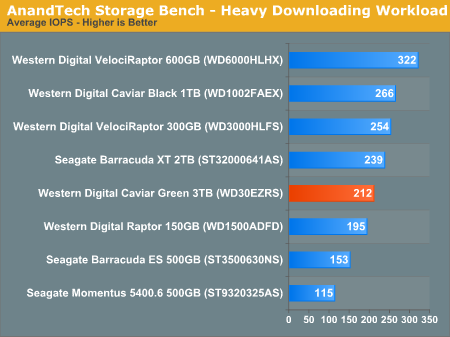
The more sequential the workload, the more the Caviar Green is going to behave like a normal high performance drive. In this case we're very close to the performance of Seagate's 7200RPM Barracuda XT 2GB (and presumably the upcoming 3TB version). The strong showing here is due to Western Digital's high areal density.
The gaming workload is made up of 75,206 read operations and only 4,592 write operations. Only 20% of the accesses are 4KB in size, nearly 40% are 64KB and 20% are 32KB. A whopping 69% of the IOs are sequential, meaning this is predominantly a sequential read benchmark. The average queue depth is 7.76 IOs.
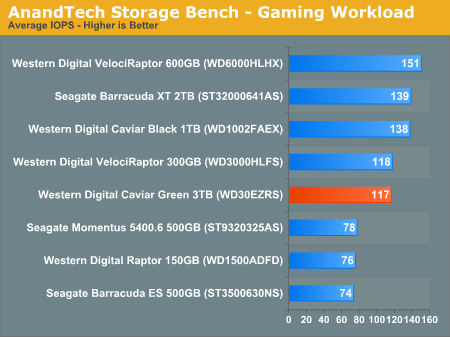
Read performance is decent, but a good 7200RPM drive will still be a bit faster. The 3TB Caviar Green will serve as a good place to store movies, music and photos but if you're a gamer concerned about load times you might want to stick with a 7200RPM drive.
Power Consumption
Idle power consumption is very good for the 3TB Green drive. Under load (sequential writes) the power consumption is still lower than any of the 7200RPM alternatives but higher than the 2.5" VelociRaptors. Overall power consumption is very good for the drive.
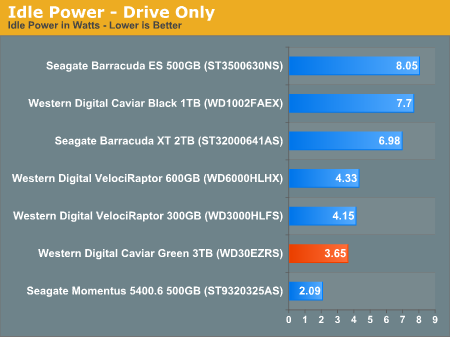
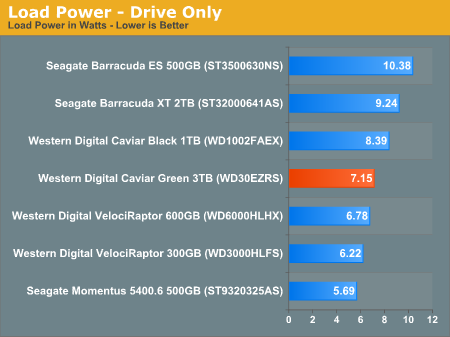
Final Words
At $239 for an internal drive, the 3TB offering isn't too expensive. You can shave off another penny or two per GB if you go with a smaller drive, but if you want the space of a single drive Western Digital's offering isn't a bad deal. You have to go into this purchase with the right expectations however.
The performance difference between the 3TB Caviar Green and a modern 7200RPM drive can be significant depending on your workload. We saw WD's 3TB drive perform a lot like a notebook hard drive depending on the workload. If all you're using it for is to store large files, photos, videos, etc... then you'll be fine. But I wouldn't recommend using it as a boot/application drive, the random performance and even light workload performance just doesn't measure up.
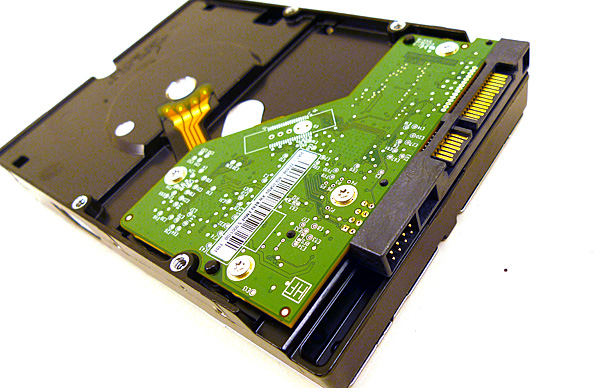
The 3TB drive (or a pair of them in RAID 1) would be a great companion to an SSD for all of your mass storage needs. As SSDs grow in size and popularity, I'm not sure we'll need to have 7200RPM hard drives in desktops any longer. These sub-6K RPM drives may be enough to get the job done. Sequential read/write speed is within 10% of Seagate's 2TB 7200RPM Barracuda XT, and I suspect that's all you need if you have a very fast SSD for your OS and applications.
As far as the external drive goes. Kudos to Western Digital for a well executed chassis, however I am concerned about the somewhat erratic read/write performance I noted in my testing of the drive.







